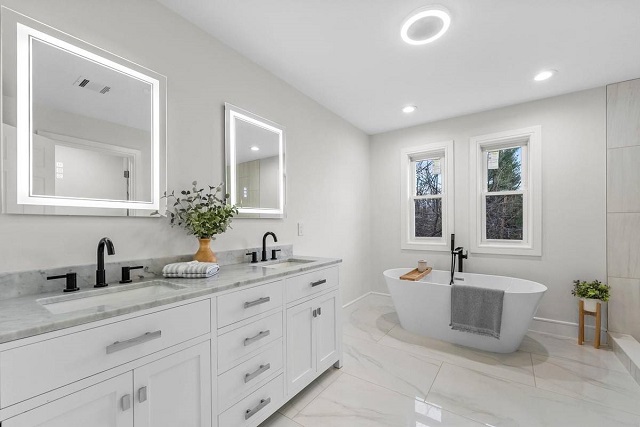Painting Techniques for a Professional Finish

Table of Contents
Painting Tools and Supplies You’ll Need
Before you embark on any painting project, it’s important to gather all the necessary tools and supplies. Having the right equipment will not only make the painting process more efficient but also ensure a professional-looking finish. Here are some essential items you’ll need:
Brushes: Invest in a variety of brushes in different sizes and materials. Synthetic brushes are ideal for water-based paints, while natural bristle brushes work well with oil-based paints. Flat brushes are great for large areas, while angled brushes are perfect for cutting in and detailed work.
Rollers and Roller Covers: A roller is an excellent choice for painting large surfaces quickly. Look for a roller with a compatible handle and a variety of roller covers to accommodate different textures and finishes. High-density foam covers work well with smooth surfaces, while rougher surfaces may require napped covers for better paint distribution.
Painter’s Tape: This low-tack tape is a valuable tool for achieving clean and crisp edges. Use it to mask off areas you want to protect from paint. Make sure to remove the tape immediately after painting to prevent any unwanted peeling.
Drop Cloths: Protect your floors, furniture, and surrounding areas from splatters and spills by laying down drop cloths. Canvas or plastic drop cloths are durable and easy to clean.
Primer: Before applying paint, prepare your surface with a primer. This will create a smooth base, hide imperfections, and enhance paint adhesion.
Paint Trays and Liners: Pour your paint into a tray for easy access while painting. Using disposable tray liners will save you time and effort when it comes to cleaning up.
Stir Sticks: Always give your paint a good stir before using it. Stir sticks are inexpensive and help ensure a consistent color and texture throughout your project.
Extension Poles: These handy tools allow you to reach high or difficult-to-access areas, such as ceilings or walls behind furniture.
As you gather these essential tools and supplies, you’ll be well-equipped to tackle any painting project that comes your way. Remember, using quality equipment and materials will ultimately contribute to a professional and long-lasting result.
Choosing the Right Paint for Your Project
When embarking on a painting project, one crucial aspect to consider is choosing the right paint for the job. The variety of paint options available can be overwhelming, but understanding the differences between them will help you make an informed decision.
Firstly, you’ll want to determine whether you need oil-based or water-based paint. Oil-based paints are known for their durability and resistance to wear and tear, making them suitable for high-traffic areas like hallways and kitchens. On the other hand, water-based paints, also known as latex paints, are more environmentally friendly, dry faster, and have less odor. They are ideal for most interior and exterior applications and are easily cleaned with soap and water. Additionally, consider the finish you desire, such as matte, eggshell, satin, semi-gloss, or high-gloss. The finish will affect both the aesthetics and functionality of the painted surface.
Next, take into account the specific area or surface you will be painting. Different surfaces require different types of paint. For example, if you’re painting a bathroom or kitchen with high moisture levels, it’s crucial to choose a paint that is mold and mildew resistant. If you’re working on a wood surface, opt for a paint formulated for wood, as it will provide better coverage and adhesion. Similarly, if you’re painting metal, choose a paint specifically designed for metal surfaces to ensure longevity and protection against rust. Understanding the specific requirements of your project will help you select the most suitable paint for the job, resulting in a successful outcome.
Preparing the Surface for Painting
Before beginning any painting project, it is crucial to properly prepare the surface to ensure a smooth and long-lasting finish. The first step in preparing the surface for painting is to clean it thoroughly. This involves removing any dirt, dust, or grime that may be present. Use a mild detergent and water to clean the surface, and then rinse it thoroughly to remove any residue. Pay extra attention to areas that are prone to mold or mildew, such as bathrooms or kitchens, and use a bleach solution to kill any existing mold or mildew.
After cleaning, it is essential to repair any imperfections on the surface. Inspect the area for any cracks, holes, or dents, and use a suitable filler to repair them. Depending on the type of surface, you may need to use spackling compound for drywall or wood filler for wooden surfaces. Smooth out the filler using a putty knife, and allow it to dry completely before sanding it down. Sanding the surface will create a smooth and even base for the paint. Start with a coarse-grit sandpaper to remove any roughness or bumps, and then switch to a finer-grit sandpaper for a finer finish. Remember to wear a face mask and goggles to protect yourself from dust while sanding.
Cleaning and Repairing the Surface
Before you begin painting, it is essential to properly clean and repair the surface you plan to work on. This step ensures that the paint adheres smoothly and provides a long-lasting finish. Start by removing any dirt, dust, or grime from the surface using a mild detergent and water solution. Gently scrub the area with a sponge or soft brush, making sure to pay attention to corners and crevices. Once cleaned, rinse thoroughly and allow the surface to dry completely.
Next, assess the surface for any damage or imperfections that may need to be repaired before painting. Fill in any holes, cracks, or dents with a suitable filler, such as spackle or putty. Smooth the filler with a putty knife, ensuring it is level with the surrounding surface. For larger repairs, like damaged drywall, consider using joint compound and applying it in thin layers, allowing each layer to dry before adding the next. Once the repairs are complete, sand the surface lightly to create a smooth and even finish. Removing any excess dust will prevent it from mixing with the paint and potentially affecting the final result.
Applying Primer for a Smooth Base
Applying primer before painting is an essential step in achieving a smooth and flawless finish. Primer helps in creating a uniform surface by filling in any imperfections or unevenness on the surface. It also provides a good base for the paint to adhere to, ensuring better durability and longevity of the paint job. Before applying the primer, make sure to clean the surface thoroughly and remove any dirt or debris. This will ensure that the primer adheres properly and creates a smooth base for the paint.
When choosing a primer, consider the type of surface you are working on. There are different types of primers available for various surfaces such as wood, metal, or drywall. Opt for a primer that is specifically designed for the surface you are painting. Also, check if the primer is compatible with the type of paint you will be using. This will ensure proper adhesion and compatibility between the primer and the paint, resulting in a smooth and professional-looking finish. Remember to follow the manufacturer’s instructions for the primer regarding application techniques and drying times. Applying the primer correctly will create a smooth base that will make the paint adhere better and provide a flawless finish for your project.
Understanding Different Types of Paint Finishes
The type of paint finish you choose can greatly impact the overall look and feel of your painted surface. There are several different options available, each with its own unique characteristics. One common type of finish is matte, which has a low sheen and is perfect for hiding imperfections on walls. If you’re looking for a bit more shine, satin or eggshell finishes provide a subtle glow and are easier to clean than matte finishes. For those who want a high-gloss appearance, gloss finishes offer a reflective surface that can be quite striking. It’s important to consider the desired aesthetic and practicality of the space when choosing the right paint finish for your project.
Another factor to keep in mind when selecting a paint finish is the durability and functionality it offers. For high-traffic areas like hallways or children’s rooms, a durable finish such as semi-gloss or gloss can withstand more wear and tear and is easier to clean. On the other hand, if you’re painting a ceiling or an area that won’t be touched often, a matte or flat finish might be more suitable. Additionally, some finishes, like metallic or textured finishes, can add a unique and artistic touch to your surface, making them a great choice for accent walls or special projects. Understanding the different types of paint finishes available allows you to make an informed decision that will not only enhance the visual appeal of your space but also ensure its longevity.
Using a Brush for Precise Painting
A brush is a versatile tool that allows you to achieve precise and detailed painting. When using a brush for precise painting, it is important to choose the right brush for the job. Different types of brushes have different bristle shapes and sizes, which can affect the outcome of your painting. For fine details and intricate work, a small brush with a fine tip is ideal. On the other hand, larger brushes with broader bristles are better suited for covering larger areas. Experimenting with different brushes will help you determine which ones work best for your specific needs.
Once you have chosen the right brush, it is important to maintain a steady hand for precise painting. Apply a moderate amount of pressure to ensure that the paint is evenly distributed on the surface. It is also advisable to use short strokes and work in small sections to maintain control over the brush. This will allow you to achieve accurate lines and edges. Additionally, taking breaks and stepping back to assess your progress can help you identify any areas that may require further attention. With practice and patience, using a brush for precise painting can yield professional-looking results.
Mastering the Roller Technique for Large Surfaces
The roller technique is an essential skill to master when painting large surfaces. Whether you’re giving your walls a fresh coat of paint or tackling a bigger project like painting a room, using a roller can help you achieve a smooth and even finish. To start, make sure you have the right tools: a roller handle, a roller cover, a paint tray, and a roller extension pole if needed. The roller cover should be the appropriate nap length for the surface you’re painting—rough surfaces require longer naps, while smooth surfaces call for shorter naps. Once you have your tools ready, pour the paint into the tray and load the roller by rolling it through the paint, ensuring an even coating on the cover.
When applying the paint with the roller, start in an area away from corners and edges, working in a W or M pattern to distribute the paint evenly. This technique helps to avoid visible roller marks and overlapping strokes. Apply enough pressure to transfer the paint onto the surface, but not too much that it drips or causes streaks. Remember to always work in one direction, whether it’s up and down or side to side, to maintain consistency. Take breaks during the process to step back and assess the coverage, making any necessary touch-ups or adjustments. With practice, you’ll be able to confidently master the roller technique and achieve professional-looking results on large surfaces.
Achieving a Seamless Finish with a Paint Sprayer
Achieving a seamless finish with a paint sprayer requires proper technique and attention to detail. When using a paint sprayer, it is important to select the right type of paint for the job. Whether you are painting walls, furniture, or other surfaces, choosing a paint that is compatible with your sprayer will help you achieve a smooth and even application. Additionally, using a high-quality paint that is designed for sprayers will help to prevent clogging and ensure a flawless finish. It is also crucial to properly prepare the surface before using a paint sprayer. This includes cleaning the surface thoroughly and ensuring it is free from dust, dirt, and any imperfections. By taking the time to prepare the surface properly, you can ensure that the paint adheres well and provides a seamless and long-lasting finish.
Adding Texture with Different Painting Techniques
To elevate the visual interest of your painted surface, consider incorporating various texture techniques. Texture not only adds depth and uniqueness to the overall finish, but it can also hide imperfections or create a focal point. One popular technique is stippling, which involves using a brush or sponge to create small dots or dabs of paint on the surface. This method is often used to mimic the texture of fabrics or create a subtle pattern. Another technique is sponging, where a damp sponge is dipped in paint and then applied to the surface in a stippling or blotting motion. This creates a mottled or sponge-like effect, perfect for achieving the look of aged or weathered walls. Crackle painting is another option for adding texture. It involves applying a base coat of paint followed by a special crackle glaze. As the glaze dries, it cracks, revealing the base coat underneath, resulting in an antique, weathered appearance.
In addition to these techniques, you can also experiment with dragging, combing, or ragging for unique textures. Dragging involves pulling a brush or comb through wet paint, creating linear or striated patterns. Combing uses a comb or specialized tool to create decorative lines or waves in the paint. Ragging, on the other hand, involves crumpling a rag and lightly pressing it onto the painted surface, creating a soft, textured effect. These techniques are ideal for adding interest to feature walls or focal points within a room. Ultimately, the choice of which texture technique to utilize depends on your desired outcome and the style of the space. By adding texture, you can transform a plain painted surface into a visually captivating masterpiece.
Creating Depth and Dimension with Layering
Layering is a technique that can add depth and dimension to your paintings, bringing them to life. By applying multiple layers of paint, you can create an illusion of texture and depth that makes your artwork visually captivating. One way to achieve this effect is through glazing, which involves applying thin layers of transparent or translucent paint over dried layers of color. This technique allows previous layers to shine through, creating a sense of richness and luminosity in your artwork. By carefully controlling the opacity and color of each layer, you can build up complexity and depth, resulting in a stunning final composition.
Another method for creating depth and dimension through layering is by utilizing different paint mediums. You can experiment with acrylic glazes, oil washes, or watercolor washes, depending on your preferences and the desired effect. Each medium has its unique characteristics and properties, allowing you to achieve various textures and visual effects. By combining these different mediums and layering them on top of each other, you can create rich, multidimensional surfaces that engage the viewer’s eye. This technique not only adds depth but also adds interest and complexity to your artwork, elevating it to a new level of artistic expression.
Tips for Achieving Clean and Crisp Edges
One of the key factors in achieving clean and crisp edges when painting is proper preparation. Before starting your project, make sure to thoroughly clean the surface you’ll be painting on. Remove any dirt, dust, or grease using soap and water or a mild cleaner. This will ensure that the paint adheres properly and doesn’t flake or chip off easily. Additionally, use painter’s tape to mask off the edges you want to keep clean. Applying the tape carefully and evenly will help prevent paint from bleeding and create sharp lines.
Another tip for achieving clean and crisp edges is to use a high-quality brush or paint trimmer. A brush with sharp and clean bristles will give you more control and allow for precise painting. Make sure to load the brush with just the right amount of paint, neither too much nor too little. Apply the paint using smooth and even strokes along the taped edges, using light pressure. This will help achieve a seamless finish and prevent any smudging or drips. Remember to remove the painter’s tape while the paint is still slightly wet to avoid any peeling or tearing. By following these tips, you can achieve professional-looking edges that will elevate the overall quality of your painted surface.
• Thoroughly clean the surface before painting to ensure proper adhesion
• Use painter’s tape to mask off edges and prevent paint bleeding
• Use a high-quality brush or paint trimmer with sharp bristles for precise painting
• Load the brush with just the right amount of paint to avoid drips or smudging
• Apply paint using smooth and even strokes along taped edges, using light pressure
• Remove painter’s tape while the paint is still slightly wet to avoid peeling or tearing
Protecting and Maintaining Your Painted Surface
Once you have successfully painted a surface, it is crucial to take the necessary steps to protect and maintain the finish. One key aspect of protecting your painted surface is ensuring that it is adequately sealed. This can be achieved by using a clear topcoat or sealant specifically designed for the type of paint you have used. Applying a topcoat not only adds an additional layer of protection, but it also helps to enhance the durability and longevity of the painted surface. It acts as a shield against elements such as moisture, sunlight, and everyday wear and tear.
Regular cleaning is essential in maintaining the appearance and condition of your painted surface. Dust, dirt, and grime can accumulate over time, making your paint job look dull and faded. To prevent this, it is recommended to use a gentle cleanser or mild soap mixed with water to clean the painted surface. Avoid using abrasive materials or harsh chemicals that can potentially damage the paint. Gently wipe the surface with a soft cloth or sponge, paying attention to any areas that may be prone to stains or spills. Regular cleaning not only keeps your painted surface looking fresh and vibrant but also helps to prolong its lifespan.
What tools and supplies do I need for painting?
You will need a paintbrush, roller, paint tray, drop cloths, painter’s tape, sandpaper, a putty knife, primer, and the paint color of your choice.
How do I choose the right paint for my project?
Consider factors such as the type of surface, the room’s lighting, and the desired finish. Consult with a paint specialist at your local home improvement store for guidance.
How do I prepare the surface before painting?
Start by cleaning the surface thoroughly, removing any dirt or grease. Then, sand it down to create a smooth surface and patch any holes or cracks with a filler.
How do I clean and repair the painted surface?
Use a mild detergent and water solution to clean the surface. If there are any damages, like chipped paint, scrape off the loose paint and repair it with a suitable filler.
When should I use a primer?
A primer is necessary when painting over a porous surface or when the existing paint is in poor condition. It helps create a smooth and even base for your new paint.
What are the different types of paint finishes?
Paint finishes include matte, eggshell, satin, semi-gloss, and gloss. Each finish has its own aesthetic appeal and durability, so choose one that suits your preferences and needs.
How do I achieve clean and precise painting using a brush?
Load the brush properly with paint, use steady and even strokes, and take your time. Use painter’s tape to mask off areas where you want crisp edges.
What is the roller technique for painting large surfaces?
Use a roller cover suitable for your project and apply an even coat of paint in a “W” or “M” motion. Roll in sections, keeping a wet edge to avoid visible lines.
How can I achieve a seamless finish using a paint sprayer?
Practice using the paint sprayer before starting your project. Apply thin and even coats, overlapping each pass slightly. Maintain a consistent distance and speed while spraying.
How can I add texture to my painted surface?
Techniques like ragging, stippling, or sponging can be used to create texture. Experiment with different tools and methods to achieve the desired effect.
How can I create depth and dimension in my painting?
Layering different shades of the same color or using contrasting colors can create depth and dimension. Blend the colors smoothly to achieve a seamless transition.
What are some tips for achieving clean and crisp edges?
Use painter’s tape to mask off the edges before painting. Remove the tape while the paint is still slightly wet to prevent it from pulling off any dried paint.
How can I protect and maintain my painted surface?
Avoid using abrasive cleaners, protect the surface from excessive moisture or direct sunlight, and touch up any chipped or damaged areas as soon as possible. Regularly clean the surface with a gentle cleaner to maintain its appearance.






